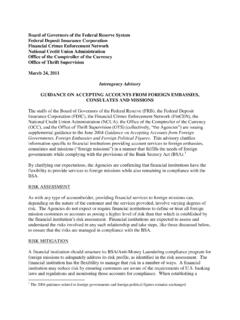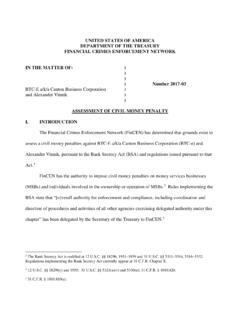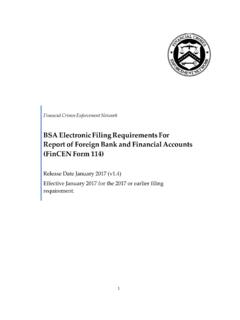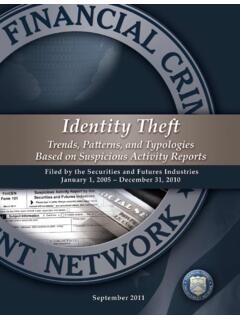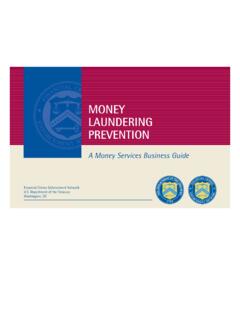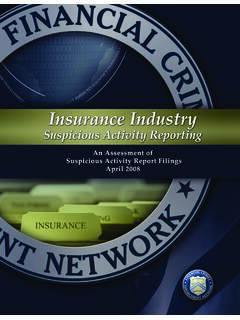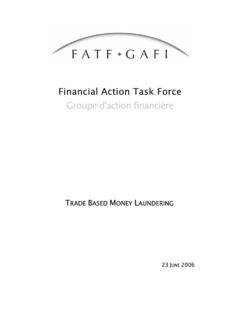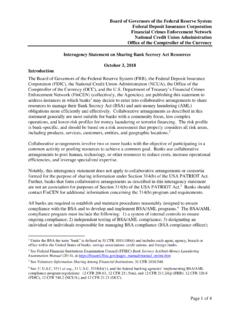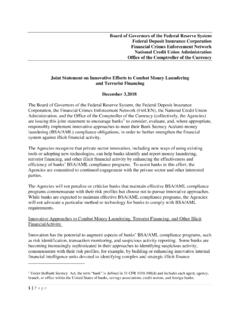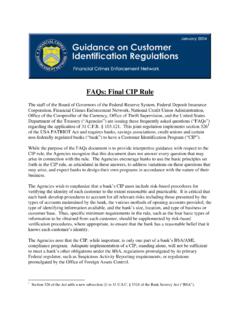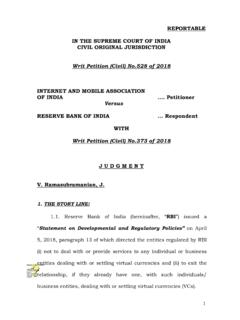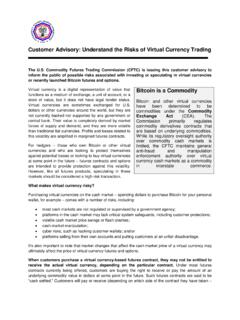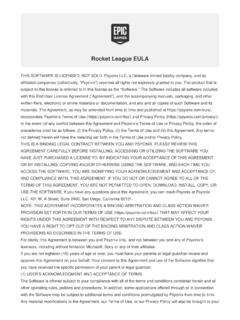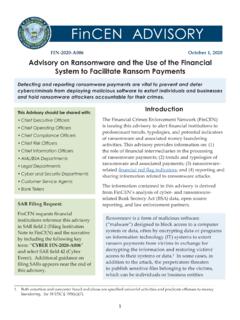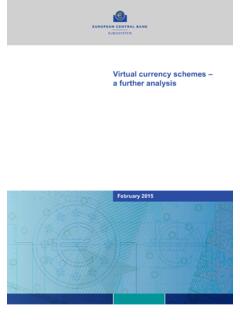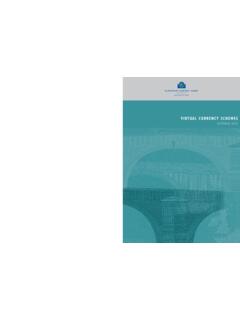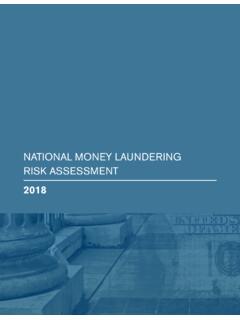Transcription of FinCEN Ransomware Advisory
1 1 FIN-2021-A004 November 8, 2021 Advisory on Ransomware and the Use of the Financial System to Facilitate Ransom Payments Detecting and reporting Ransomware payments are vital to holding Ransomware attackers accountable for their crimes and preventing the laundering of Ransomware FIN-2020-A0062. See Department of the Treasury Press Release, Treasury Continues Campaign to Combat Ransomware As Part of Whole-of-Government Effort, (Oct. 15, 2021); and FinCEN , Financial Trend Analysis: Ransomware Trends in Bank Secrecy Act Data Between January 2021 and June 2021 ( FinCEN 2021 Ransomware Report), at 3 (Oct. 15, 2021); see also White House, FACT SHEET: Ongoing Public Efforts to Counter Ransomware (Oct. 13, 2021).IntroductionThe Financial Crimes Enforcement Network ( FinCEN ) is updating and replacing its October 1, 2020 Advisory on Ransomware and the Use of the Financial System to Facilitate Ransom This updated Advisory is in response to the increase of Ransomware attacks in recent months against critical infrastructure, such as the May 2021 Ransomware attack that disrupted the operations of Colonial Pipeline, the largest pipeline system for refined oil products in the United States.
2 This attack led to widespread gasoline shortages that affected tens of millions of Americans. Other recent targets include entities in the manufacturing, legal services, insurance, financial services, health care, energy, and food production sectors. FinCEN issued the original Advisory to alert financial institutions to predominant trends, typologies, and potential indicators of Ransomware and associated money laundering activities. The Advisory provided information on: (1) the role of financial intermediaries in the processing of Ransomware payments; (2) trends and typologies of Ransomware and associated payments; (3) Ransomware -related financial red flag indicators; and (4) reporting and sharing information related to Ransomware attacks. This amended Advisory reflects information released by FinCEN in its Financial Trend Analysis Report issued on October 15, 2021, and is part of the Department of the Treasury s broader efforts to combat In particular, this updated Advisory identifies new trends This Advisory should be shared with: Chief Executive Officers Chief Operating Officers Chief Compliance Officers Chief Risk Officers AML/BSA Departments Legal Departments Cyber and Security Departments Customer Service Agents Bank TellersSAR Filing RequestFinCEN requests financial institutions reference this Advisory in SAR field 2 (Filing Institution Note to FinCEN ) and the narrative by including the following key term: CYBER FIN-2021-A004 and select SAR field 42 (Cyber Event).
3 Additional guidance for filing SARs appears near the end of this ADVISORY2and typologies of Ransomware and associated payments, including the growing proliferation of anonymity-enhanced cryptocurrencies (AECs) and decentralized Additionally, in October 2020, the Department of Justice (DOJ) released Cryptocurrency: An Enforcement Framework, a publication produced by the Attorney General s Cyber-Digital Task Force. The Framework provides a comprehensive overview of the emerging threats and enforcement challenges associated with the increasing prevalence and use of cryptocurrency; details the important relationships that the DOJ has built with regulatory and enforcement partners both within the government and around the world; and outlines the DOJ s response strategies. Among other topics, the Framework discusses the use of cryptocurrency as a payment method by bad actors to facilitate ransom and information contained in this Advisory is derived from FinCEN s analysis of cyber and Ransomware -related Bank Secrecy Act (BSA) data, open source reporting, and law enforcement is a form of malicious software ( malware ) designed to block access to a computer system or data, often by encrypting data or programs on information technology (IT) systems to extort ransom payments from victims in exchange for decrypting the information and restoring victims access to systems or In some cases, in addition to the encrypting information, the perpetrators threaten to publish sensitive files belonging to the victims, which can be individuals or business entities (including financial institutions).
4 The consequences of a Ransomware attack can be severe and far-reaching with losses of sensitive, proprietary, and critical information and/or loss of business Role of Financial Intermediaries in Facilitating Ransomware PaymentsRansomware attacks are a growing concern for the financial sector because of the critical role financial institutions play in the collection of ransom payments. Processing Ransomware payments is typically a multi-step process that involves at least one depository institution and one or more entities directly or indirectly facilitating victim payments, including money services businesses (MSB). Most Ransomware schemes involve convertible virtual currency (CVC), the preferred payment method of Ransomware perpetrators. Following the delivery of the ransom demand, a Ransomware victim will typically transmit funds via wire transfer, automated clearinghouse, or credit card payment to a CVC exchange to purchase the type and amount of CVC specified by the Ransomware perpetrator.
5 Next, the victim or an entity working on the victim s behalf sends the CVC, often from a wallet hosted6 at the exchange, to the perpetrator s designated account or CVC 3. See FinCEN 2021 Ransomware Report, at 2, 3, 9, 12-13 (Oct. 15, 2021).4. See DOJ Report of the Attorney General s Cyber Criminal Task Force, Cryptocurrency: An Enforcement Framework (Oct. 2020) (hereinafter, DOJ Cryptocurrency Enforcement Framework); see also DOJ Press Release, Attorney General William P. Barr Announces Publication of Cryptocurrency Enforcement Framework, (Oct. 8, 2020).5. Both extortion and computer fraud and abuse are specified unlawful activities and predicate offenses to money laundering. See 18 1956(c)(7).6. Hosted wallets are CVC wallets where the CVC exchange receives, stores, and transmits the CVCs on behalf of their accountholders. See FinCEN Guidance, FIN-2019-G001, Application of FinCEN s Regulations to Certain Business Models Involving Convertible virtual Currencies, (May 9, 2019).
6 FinCEN ADVISORY3address. The perpetrator then launders the funds through various means including mixers, tumblers,7 and chain hopping8 to convert funds into other CVCs. These transactions may be structured into smaller smurfing 9 transactions involving multiple people, and across many different CVC addresses, accounts, and exchanges, including peer-to-peer (P2P)10 and nested exchanges. Criminals prefer to launder their Ransomware proceeds in jurisdictions with weak anti-money laundering and countering financing of terrorism (AML/CFT) insurance companies (CICs) and digital forensic and incident response (DFIR) companies can also play a role in Ransomware transactions. CICs issue policies designed to mitigate an entity s losses from a variety of cyber incidents, such as data breaches, business interruption, and network damage. CICs may reimburse policyholders for particular remediation services including the use of DFIRs if needed.
7 As part of incident remediation, affected entities may hire a DFIR company to negotiate with the cybercriminal, facilitate payment to the cybercriminal, and investigate the source of the cybersecurity breach. Figure 1. Movement of CVC in Ransomware IncidentsVICTIMDEPOSITORYINSTITUTIONSDFI RMONEY LAUNDERINGATTACKER/AFFILIATESDEXSSUSPICI OUSCVC ADDRESSMIXERSCVCEXCHANGESCVCEXCHANGESCVC EXCHANGESCICE ntitiesFacilitatingVictim PaymentsEntitiesFacilitating ObfuscationCash-OutKEYDFIR: Digital Forensic and Incident ResponseCIC: Cyber Insurance CompanyDEXs: Decentralized Exchanges7. Mixing or tumbling involves the use of mechanisms to break the connection between an address sending CVC and the addresses receiving CVC. For more information, see FinCEN 2021 Ransomware Report, at 13 (Oct. 15, 2021).8. Chain hopping is a cross- virtual -asset layering technique for users attempting to conceal criminal behavior.
8 Criminals obfuscate the trail of virtual currency by shifting the trail of transactions from the blockchain of one virtual currency to the blockchain of another virtual currency , often in rapid succession. See DOJ Cryptocurrency Enforcement Framework, at Smurfing refers to a layering technique in money laundering that involves breaking total amounts of funds into smaller amounts to move through multiple accounts before arriving at the ultimate P2P exchangers are individuals or entities offering to exchange fiat currencies for virtual currencies or one virtual currency for another virtual currency . P2P exchangers usually operate informally, typically advertising and marketing their services through online classified advertisements or fora, social media, and by word of mouth. See FinCEN Advisory , FIN-2019-A003, Advisory on Illicit Activity Involving Convertible virtual currency , (May 9, 2019).
9 FinCEN ADVISORY4 Some DFIR companies and CICs, as well as some MSBs that offer CVCs, facilitate Ransomware payments to cybercriminals, often by directly receiving customers fiat funds, exchanging them for CVC, and then transferring the CVC to criminal-controlled accounts. Depending on the particular facts and circumstances, this activity could constitute money transmission. Entities engaged in MSB activities (such as money transmission) are required to register as an MSB with FinCEN , and are subject to BSA obligations, including filing FinCEN will not hesitate to take action against entities and individuals engaged in money transmission or other MSB activities if they fail to register with FinCEN or comply with their other AML involved in Ransomware payments must also be aware of any Office of Foreign Assets Control (OFAC)-related obligations that may arise from that On September 21, 2021, OFAC issued an updated Advisory highlighting the sanctions risks associated with facilitating Ransomware payments on behalf of victims targeted by malicious cyber-enabled Additionally, in October 2021, OFAC issued sanctions compliance guidance for the virtual currency industry, which provides an overview of key items such as reporting instructions, consequences of non-compliance, and compliance best Trends and Typologies of Ransomware and Associated Payments The severity and sophistication of Ransomware attacks continue to rise15 across various sectors, particularly across governmental entities, and financial, educational, and healthcare Ransomware attacks on small municipalities and healthcare organizations have increased.
10 Likely due to the victims weaker cybersecurity controls, such as inadequate system backups and ineffective incident response using Ransomware often resort to common tactics, such as wide-scale phishing and targeted spear-phishing campaigns that induce victims to download a malicious file or go to a malicious site, exploit remote desktop protocol endpoints and software vulnerabilities, or deploy drive-by malware attacks that host malicious code on legitimate websites. Proactive prevention through effective cyber hygiene, cybersecurity controls, and business continuity resiliency is often the best defense against On July 15, 2021, the government announced 11. See generally 31 CFR Part 1022; and 31 CFR (ff).12. See OFAC, Sanctions Compliance Guidance for the virtual currency Industry, (Oct. 15, 2021); FinCEN Ransomware Report 2021, at 13 (Oct. 15, 2021); and White House, FACT SHEET: Ongoing Public Efforts to Counter Ransomware , (Oct.)
